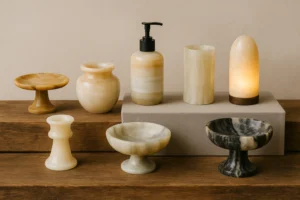Introduction
As sustainability becomes an increasingly important factor in design, more homeowners and designers are turning to artisanal, handcrafted materials to create timeless and eco-conscious living spaces. Among these materials, handcrafted stoneware stands out for its unique beauty, sustainability, and connection to traditional craftsmanship. Unlike mass-produced items, handcrafted stoneware is created with care and attention to detail, reflecting the artisan’s skill and commitment to preserving ancient techniques. This article explores the role of handcrafted stoneware in contemporary living, highlighting its environmental benefits, aesthetic appeal, and lasting value.
The Beauty of Handcrafted Stoneware
Handcrafted stoneware is not just a functional object; it is a piece of art. Each item, whether it is a decorative vessel, a sculpture, or a piece of furniture, is imbued with the craftsmanship and story of its maker. The process of creating handcrafted stoneware involves a deep understanding of the material, as artisans carve, polish, and shape the stone by hand, ensuring that no two pieces are identical. This attention to detail results in unique, one-of-a-kind items that add character and individuality to any home.
The use of natural stone in these items brings texture and depth to modern interiors, whether in the form of sleek marble vases, intricate onyx lamps, or sturdy stone sculptures. The natural variations in color, veining, and texture of the stone ensure that each piece is distinctive, making it a standout feature in any room.
Sustainability: A Core Principle of Handcrafted Stoneware
In an era where sustainability is at the forefront of design discussions, handcrafted stoneware offers a sustainable alternative to mass-produced home decor items. Unlike plastic or synthetic materials, which have a limited lifespan and contribute to environmental waste, handcrafted stoneware is made from natural, durable materials that can last for generations. The use of stone—especially materials like marble, onyx, and limestone—ensures that each piece is both long-lasting and eco-friendly.
Furthermore, the process of crafting stoneware by hand is inherently low-impact. Traditional techniques require minimal energy and produce little waste, particularly when compared to factory-based manufacturing. Many artisans source their materials locally, further reducing their carbon footprint. By investing in handcrafted stoneware, homeowners are making a conscious choice to support sustainable, eco-conscious production practices.
The Timelessness of Stone in Contemporary Interiors
One of the most compelling qualities of handcrafted stoneware is its timeless appeal. Natural stone has been used for centuries in architecture and art, and it continues to be a symbol of durability and elegance. In modern interiors, stone’s enduring beauty adds a touch of sophistication and refinement that never goes out of style.
Whether used in minimalistic decor or incorporated into more elaborate designs, stone complements a wide range of styles, from contemporary and industrial to rustic and traditional. The smooth, polished surfaces of stone items create a sense of luxury, while the raw, unrefined edges evoke a connection to nature. This balance between modernity and tradition makes handcrafted stoneware a versatile and timeless addition to any home.
Handcrafted Stoneware as an Investment
Investing in handcrafted stoneware is more than just purchasing an item—it is an investment in quality, sustainability, and artistry. While mass-produced decor items may be cheaper, they lack the uniqueness and longevity that handcrafted stone pieces offer. Each handcrafted stoneware item is built to last, making it a valuable heirloom that can be passed down through generations.
Additionally, the artistic value of handcrafted stoneware cannot be overstated. These pieces are not just functional; they are expressions of culture, craftsmanship, and tradition. Whether it’s a stone sculpture created by a local artisan or a hand-carved stone vessel, each piece holds sentimental and cultural value that can enrich the home for years to come.
Incorporating Handcrafted Stoneware into Your Home
The versatility of handcrafted stoneware makes it easy to incorporate into various areas of your home. In living rooms, stone sculptures or decorative bowls can add an artistic focal point, while stone trays and vases enhance the beauty of coffee tables and mantels. In kitchens, stoneware can be used for countertops, serving trays, and decorative accents, providing both function and beauty.
For those seeking a sustainable and timeless approach to interior design, integrating handcrafted stoneware into their decor not only supports artisans but also fosters a connection to nature and tradition. Whether placed in a modern apartment or a rustic home, these pieces create a sophisticated and eco-conscious atmosphere.
Conclusion
Handcrafted stoneware is more than just a decor trend—it is a sustainable, timeless, and beautiful addition to modern interiors. With its unique beauty, eco-friendly production methods, and lasting durability, it represents a perfect blend of artistry and sustainability. By embracing handcrafted stoneware in contemporary design, homeowners can create spaces that are not only beautiful and functional but also meaningful, reflecting a commitment to quality, tradition, and environmental responsibility.



